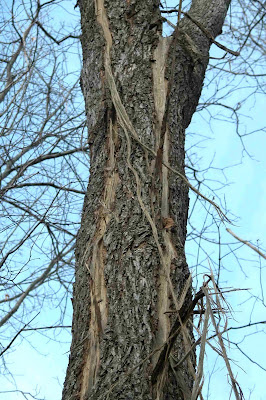 Lightning strikes about 100 times each second somewhere on Earth (see NASA's Lightning Primer).
Lightning strikes about 100 times each second somewhere on Earth (see NASA's Lightning Primer).About 2000 active thunderstorms rain electrical discharges at any given moment, mostly during spring and summer.
One of these thunderstorms found this Lawrence County, Ohio hickory tree, a ready conductor between airy thermal and moist ground.
This tree shows damage from a double-strike, right and left spalls. Lightning's strobe-effect results from repeat strikes separated by 40 or 50 milliseconds. Two of these repeat strikes hit this hickory tree last summer. Each strike lifted a series of long splintery spalls exposing sapwood.
Lightning's enormous current is conducted mainly along surfaces: This is known as the skin-effect. The skin-effect often results in damage to the bark and outer sapwood of trees, leaving the core of the tree relatively undamaged. The spalls seen here are about two inches deep, at most.
This hickory is alive today, and may repair the damage, or it may be stricken in years to come by secondary infestations. Many trees heal-over lightning damage, and go on shading the forest floor for decades or centuries.
Many forms of disturbance modify forests annually, opening niches for diverse organisms. What insects or fungi are adapted to exploit frequent lightning damage?
The lightning bolt's current was conducted through the inner bark and outer sapwood of this hickory tree. Internal moisture was flash-heated and instantaneously vaporized. The super-heated vapor expanded so rapidly it violently splintered bark and wood into kindling still dangling from the tree from high on a major branch, down to ground-level.
Lightning strikes occasionally result in forest fires, a natural and necessary force shaping forest composition. Most natural fires occur during dry summer months when thunderstorms are frequent and woodlands are tinder-dry. Oak seedlings and saplings survive fires more frequently than other young hardwoods like maples. Many forest professionals believe that fire-suppression during the 20th Century resulted in shifting forest compositions.
Prior to the era of massive cataclysmic wildfires resulting from accumulated logging-slash in the late 19th and early 20th Centuries, fire was a cultural tool, not a cultural fear.
Brushy Fork area, Wayne National Forest, Lawrence County, Ohio.
Native Americans and early settlers were fire-savvy. They used fire as a primary tool for clearing forest undergrowth, influencing large mammal populations, and for slash and burn agriculture. They used fire without devastating consequences: Frequent fires reduce the likelihood of destructive conflagrations.
Numerous references to fire frequency are found in contact-period literature. One early reference may be found in the Diary of George Washington*. During October and November 1770, our future first president led an expedition to the Ohio County to survey and mark tracts of land for service-grants to Virginia military officers. Washington valued Native American first-hand terrain descriptions and landscape information. In an entry for November 4, referring to Native American description of the hills flanking the Ohio River across from Millersport, Ohio, Washington writes,
Numerous references to fire frequency are found in contact-period literature. One early reference may be found in the Diary of George Washington*. During October and November 1770, our future first president led an expedition to the Ohio County to survey and mark tracts of land for service-grants to Virginia military officers. Washington valued Native American first-hand terrain descriptions and landscape information. In an entry for November 4, referring to Native American description of the hills flanking the Ohio River across from Millersport, Ohio, Washington writes,
"& to the Hills, wch. the Indians say is always a fire to which the Bottom from the Mouth of the Kanhawa continues & then ends."
*The Diaries of George Washington. Vol. 2. Donald Jackson, ed.; Dorothy Twohig, assoc. ed. The Papers of George Washington. Charlottesville : University Press of Virginia
Recommended further reading: Stephen J. Pyne's Fire in America: A Cultural History of Wildland and Rural Fire (1982; paperback edition, University of Washington Press, 1997)
Recommended further reading: Stephen J. Pyne's Fire in America: A Cultural History of Wildland and Rural Fire (1982; paperback edition, University of Washington Press, 1997)


1 comment:
Trees that get hit by lightning are usually either completely destroyed from the stump up, or are left with an odd splitting scar among its trunk. Thanks for the great tips and info, I appreciate it!
-Samudaworth Tree Service
Post a Comment